Tag Switching and Traffic Engineering
In conventional Layer 3 routing, network topologies frequently include multiple paths between two points, but the normal routing procedure is to select a single path as the Layer 3 route between two points, regardless of the load on the links that implement the path. As a consequence, some links are congested and some are underused.
Traffic engineering provides a way to override routing protocols across multiple routers. It gives you the ability to direct selected traffic over specific paths in the network in order to efficiently use network resources and provide different levels of service.
To engineer your network traffic, you follow a two-step process. First, you define a sequence of links between two routers. Tag Switching is used to tunnel packets between the two routers over these links. The links collectively form a Tag Switched path (TSP) tunnel, which defines a traffic engineering path. Second, you select the traffic that you want forwarded on to the tunnel.
Traffic Engineering Tunnels and Filters
The traffic to be engineered is specified by a traffic engineering filter. The filter is associated with a TSP tunnel using a traffic engineering path.
The router at the head of the tunnel arranges that packets matching the filter be injected into the tunnel rather than being forwarded to their Layer 3 next hop. Injection consists simply of sending the packet to the first hop in the tunnel with a tag that causes that first hop to send the packet to the second hop of the tunnel, and so on.
For the initial release of traffic engineering, the only supported filtering is by "egress address." This filter matches traffic whose destination or BGP next hop is "address."
Multiple tunnels with different preferences can be specified for a single filter. A preference is an option you can select among multiple candidate routes for a filter, with the lower-valued preference being more desirable. The most preferred of the acceptable tunnels is used for the traffic.
A loop prevention algorithm operates to ensure that a tunnel is not used for traffic that might loop back to the head of the tunnel.
Traffic Engineering Tunnel Configuration
Configuration and the initiation of the tunnel are controlled by the headend (transmit end) router. Per-tunnel configuration of other routers is unnecessary.
Routers create and maintain the traffic engineering tunnels based on information you enter through the command-line interface (CLI). See Chapter 11, "Tag Switching Commands," for more information.
